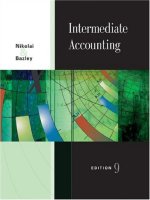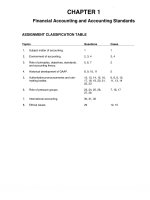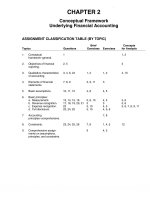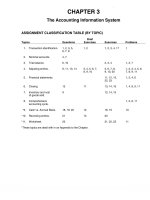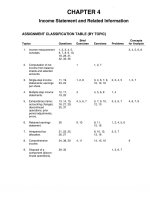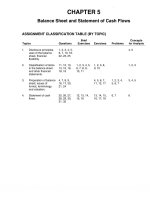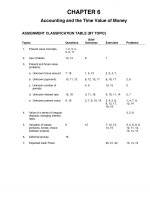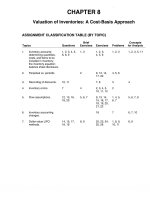Solution manual intermediate accounting 13e kieso ch22
Bạn đang xem bản rút gọn của tài liệu. Xem và tải ngay bản đầy đủ của tài liệu tại đây (439.99 KB, 72 trang )
To download more slides, ebook, solutions and test bank, visit
CHAPTER 22
Accounting Changes and Error Analysis
ASSIGNMENT CLASSIFICATION TABLE (BY TOPIC)
Topics
Questions
1.
Differences between change in
principle, change in estimate,
change in entity, errors.
2, 4, 6, 7,
8, 9, 12, 13,
15, 21, 22,
23
2.
Accounting changes:
3.
*4.
Brief
Exercises
Exercises
8
Concepts
Problems for Analysis
3
1, 2, 3, 4
3, 6, 7
1, 2, 4, 5
a.
Comprehensive.
b.
Changes in estimate,
changes in depreciation
methods.
8, 9
4, 5, 9
3, 4, 6, 7,
8, 9, 10,
11, 12,
16, 17
1, 2, 4,
6, 7
1, 2, 3,
4, 5, 6
c.
Changes in accounting
for long-term construction
contracts.
2, 10
1, 2, 10
1, 8, 13
3
1, 2
d.
Change from FIFO
to average cost.
e.
Change from FIFO to LIFO.
2, 11
f.
Change from LIFO.
g.
Miscellaneous.
2, 8, 14
3
10
9
1, 2
8
3
2, 3, 5,
8, 14
1, 3, 4, 5,
8, 24
8, 9, 10
2, 5
1, 5
Correction of an error.
a.
Comprehensive.
8, 14, 15,
17, 19
8, 9, 10
8, 15, 16,
18, 19,
20, 21
3, 6, 7, 8,
9, 10
b.
Depreciation.
2, 18, 21
6, 7
9, 15,
17, 18
1, 6, 8
c.
Inventory.
9, 16, 20
10
7, 17, 18
2, 10
11, 12
22, 23
11, 12
Changes between fair value and
equity methods.
2, 3, 4
1, 2
*This material is dealt with in an Appendix to the chapter.
Copyright © 2010 John Wiley & Sons, Inc.
Kieso, Intermediate Accounting, 13/e, Solutions Manual
(For Instructor Use Only)
22-1
To download more slides, ebook, solutions and test bank, visit
ASSIGNMENT CLASSIFICATION TABLE (BY LEARNING OBJECTIVE)
Brief
Exercises
Learning Objectives
Exercises
Problems
1. Identify the types of accounting changes.
2. Describe the accounting for changes
in accounting principles.
1
3. Understand how to account for retrospective
accounting changes.
1, 2, 3,
9, 10
1, 2, 3, 4, 5,
8, 13, 14
2, 3, 5
4, 5, 9
6, 7, 8, 9,
10, 11, 12
1, 2, 3,
4, 6
6, 7, 8, 10
7, 8, 9, 15,
16, 17, 18,
19, 20, 21
1, 2, 3, 6,
7, 8, 9, 10
18, 19, 20, 21
6, 7, 8,
9, 10
22, 23
11, 12
4. Understand how to account for impracticable
changes.
5. Describe the accounting for changes
of estimates.
6. Identify changes in a reporting entity.
7. Describe the accounting for correction of errors.
8. Identify economic motives for changing
accounting methods.
9. Analyze the effect of errors.
*10. Make the computations and prepare the entries
necessary to record a change from or to the
equity method of accounting.
22-2
Copyright © 2010 John Wiley & Sons, Inc.
11, 12
Kieso, Intermediate Accounting, 13/e, Solutions Manual
(For Instructor Use Only)
To download more slides, ebook, solutions and test bank, visit
ASSIGNMENT CHARACTERISTICS TABLE
Item
Description
Level of
Difficulty
Time
(minutes)
E22-1
E22-2
E22-3
E22-4
E22-5
E22-6
E22-7
E22-8
E22-9
E22-10
E22-11
E22-12
E22-13
E22-14
E22-15
E22-16
E22-17
E22-18
E22-19
E22-20
E22-21
*E22-22
*E22-23
Change in principle—long-term contracts.
Change in principle—inventory methods.
Accounting change.
Accounting change.
Accounting change.
Accounting changes—depreciation.
Change in estimate and error; financial statements.
Accounting for accounting changes and errors.
Error and change in estimate—depreciation.
Depreciation changes.
Change in estimate—depreciation.
Change in estimate—depreciation.
Change in principle—long-term contracts.
Various changes in principle—inventory methods.
Error correction entries.
Error analysis and correcting entry.
Error analysis and correcting entry.
Error analysis.
Error analysis and correcting entries.
Error analysis.
Error analysis.
Change from fair value to equity.
Change from equity to fair value.
Moderate
Moderate
Difficult
Difficult
Difficult
Difficult
Moderate
Simple
Simple
Moderate
Simple
Simple
Simple
Moderate
Simple
Simple
Simple
Moderate
Simple
Moderate
Moderate
Complex
Moderate
10–15
10–15
25–30
25–30
30–35
30–35
25–30
5–10
15–20
20–25
10–15
20–25
10–15
20–25
15–20
10–15
10–15
25–30
20–25
20–25
10–15
25–30
15–20
P22-1
P22-2
P22-3
P22-4
P22-5
P22-6
P22-7
P22-8
P22-9
P22-10
*P22-11
*P22-12
Change in estimate and error correction.
Comprehensive accounting change and error analysis problem.
Error corrections and accounting changes.
Accounting changes.
Change in principle—inventory—periodic.
Accounting changes and error analysis.
Error corrections.
Comprehensive error analysis.
Error analysis.
Error analysis and correcting entries.
Fair value to equity method with goodwill.
Change from fair value to equity method.
Moderate
Complex
Complex
Moderate
Moderate
Moderate
Moderate
Difficult
Moderate
Complex
Moderate
Moderate
30–35
30–40
30–40
40–50
30–35
25–30
25–30
30–35
20–25
50–60
20–25
20–25
Analysis of various accounting changes and errors.
Analysis of various accounting changes and errors.
Analysis of three accounting changes and errors.
Analysis of various accounting changes and errors.
Change in principle, estimate.
Change in estimate, ethics.
Moderate
Moderate
Moderate
Moderate
Moderate
Moderate
25–35
20–30
30–35
20–30
20–30
20–30
CA22-1
CA22-2
CA22-3
CA22-4
CA22-5
CA22-6
Copyright © 2010 John Wiley & Sons, Inc.
Kieso, Intermediate Accounting, 13/e, Solutions Manual
(For Instructor Use Only)
22-3
To download more slides, ebook, solutions and test bank, visit
SOLUTIONS TO CODIFICATION EXERCISES
CE22-1
Master Glossary
(a)
A change that has the effect of adjusting the carrying amount of an existing asset or liability or
altering the subsequent accounting for existing or future assets or liabilities. A change in accounting
estimate is a necessary consequence of the assessment, in conjunction with the periodic presentation of financial statements, of the present status and expected future benefits and obligations
associated with assets and liabilities. Changes in accounting estimates result from new information.
Examples of items for which estimates are necessary are uncollectible receivables, inventory
obsolescence, service lives and salvage values of depreciable assets, and warranty obligations.
(b)
A change from one generally accepted accounting principle to another generally accepted
accounting principle when there are two or more generally accepted accounting principles that
apply or when the accounting principle formerly used is no longer generally accepted. A change
in the method of applying an accounting principle also is considered a change in accounting
principle.
(c)
The process of revising previously issued financial statements to reflect the correction of an error
in those financial statements.
(d)
The application of a different accounting principle to one or more previously issued financial
statements, or to the statement of financial position at the beginning of the current period, as if
that principle had always been used, or a change to financial statements of prior accounting
periods to present the financial statements of a new reporting entity as if it had existed in those
prior years.
CE22-2
According to FASB ASC 250-10-50-7 (Accounting Changes and Error Corrections—Disclosure):
When financial statements are restated to correct an error, the entity shall disclose that its previously
issued financial statements have been restated, along with a description of the nature of the error. The
entity also shall disclose both of the following:
(a)
The effect of the correction on each financial statement line item and any per-share amounts
affected for each prior period presented.
(b)
The cumulative effect of the change on retained earnings or other appropriate components of
equity or net assets in the statement of financial position, as of the beginning of the earliest
period presented.
22-4
Copyright © 2010 John Wiley & Sons, Inc.
Kieso, Intermediate Accounting, 13/e, Solutions Manual
(For Instructor Use Only)
To download more slides, ebook, solutions and test bank, visit
CE22-3
According to FASB ASC 250-10-45-5 (Accounting Changes and Error Corrections—Other Presentation
Matters):
Retrospective application requires all of the following:
(a)
The cumulative effect of the change to the new accounting principle on periods prior to those
presented shall be reflected in the carrying amounts of assets and liabilities as of the beginning of
the first period presented.
(b)
An offsetting adjustment, if any, shall be made to the opening balance of retained earnings (or
other appropriate components of equity or net assets in the statement of financial position) for
that period.
(c)
Financial statements for each individual prior period presented shall be adjusted to reflect the
period-specific effects of applying the new accounting principle.
CE22-4
According to FASB ASC 250-10-S99-4 (Accounting Changes and Error Corrections—SEC Materials):
Question 5: If a registrant justified a change in accounting method as preferable under the circumstances, and the circumstances change, may the registrant revert to the method of accounting used
before the change?
Any time a registrant makes a change in accounting method, the change must be justified as preferable
under the circumstances. Thus, a registrant may not change back to a principle previously used unless
it can justify that the previously used principle is preferable in the circumstances as they currently exist.
Copyright © 2010 John Wiley & Sons, Inc.
Kieso, Intermediate Accounting, 13/e, Solutions Manual
(For Instructor Use Only)
22-5
To download more slides, ebook, solutions and test bank, visit
ANSWERS TO QUESTIONS
1.
The major reasons why companies change accounting methods are:
(1) Desire to show better profit picture.
(2) Desire to increase cash flows through reduction in income taxes.
(3) Requirement by Financial Accounting Standards Board to change accounting methods.
(4) Desire to follow industry practices.
(5) Desire to show a better measure of the company’s income.
2.
(a) Change in accounting principle; retrospective application is generally not made because it is
impracticable to determine the effect of the change on prior years. The FIFO inventory amount
is therefore generally the beginning inventory in the current period.
(b) Correction of an error and therefore prior period adjustment; adjust the beginning balance of
retained earnings.
(c) Increase income for litigation settlement.
(d) Change in accounting estimate; currently and prospectively. Part of operating section of
income statement.
(e) Reduction of accounts receivable and the allowance for doubtful accounts.
(f) Change in accounting principle; retrospective application to prior period financial statements.
3.
The three approaches suggested for reporting changes in accounting principles are:
(a) Currently—the cumulative effect of the change is reported in the current year’s income as
a special item.
(b) Retrospectively—the cumulative effect of the change is reported as an adjustment to retained
earnings. The prior year’s statements are changed on a basis consistent with the newly
adopted principle.
(c) Prospectively—no adjustment is made for the cumulative effect of the change. Previously
reported results remain unchanged. The change shall be accounted for in the period of the
change and in subsequent periods if the change affects future periods.
4.
The FASB believes that the retrospective approach provides financial statement users the most
useful information. Under this approach, the prior statements are changed on a basis consistent
with the newly adopted standard; any cumulative effect of the change for prior periods is recorded
as an adjustment to the beginning balance of retained earnings of the earliest period reported.
5.
The indirect effect of a change in accounting principle reflects any changes in current or future
cash flows resulting from a change in accounting principle that is applied retrospectively. An
example is the change in payments to a profit-sharing plan that is based on reported net income.
Indirect effects are not included in the retrospective application, but instead are reported in the
period in which the accounting change occurs (current period).
6.
A change in an estimate is simply a change in the way an individual perceives the realizability of
an asset or liability. Examples of changes in estimate are: (1) change in the realizability of trade
receivables, (2) revisions of estimated lives, (3) changes in estimates of warranty costs, and
(4) change in estimate of deferred charges or credits. A change in accounting estimate effected
by a change in accounting principle occurs when a change in accounting estimate is inseparable
from the effect of a related change in accounting principle. An example would be switching from
capitalizing advertising expenditures to expensing them if the future benefit of the expenditures
can no longer be estimated with reasonable certainty.
22-6
Copyright © 2010 John Wiley & Sons, Inc.
Kieso, Intermediate Accounting, 13/e, Solutions Manual
(For Instructor Use Only)
To download more slides, ebook, solutions and test bank, visit
Questions Chapter 22 (Continued)
7.
This is an example of a situation in which it is difficult to differentiate between a change in accounting principle and a change in estimate. In such a situation, the change should be considered a
change in estimate, and accordingly, should be handled currently and prospectively. Thus, all
costs presently capitalized and viewed as providing doubtful future values should be expensed
immediately, and costs currently incurred should also be expensed immediately.
8.
(a) Charge to expense—possibly separately disclosed.
(b) Change in estimate that is effected by a change in accounting principle—currently and
prospectively.
(c) Charge to expense—possibly separately disclosed.
(d) Correction of an error and reported as a prior period adjustment—adjust the beginning balance
of retained earnings.
(e) Change in accounting principle—retrospective application to all affected prior-period financial
statements.
(f) Change in accounting estimate—currently and prospectively.
9.
This change is to be handled as a correction of an error. As such, the portion of the change
attributable to prior periods ($23,000) should be reported as an adjustment to the beginning
balance of retained earnings in the 2010 financial statements. If statements for previous years
are presented for comparative purposes, these statements should be restated to correct for the
error. The remainder of the inventory value ($29,000) should be reported in the 2010 statements
as a reduction of materials cost.
10.
Preferability is a difficult concept to apply. The problem is that there are no basic objectives to
indicate which is the most preferable method, assuming a selection between two generally accepted
accounting practices is possible, such as completed-contract and percentage-of-completion. If a
FASB standard creates a new principle or expresses preference for or rejects a specific accounting
principle, a change is considered clearly acceptable. A more appropriate matching of revenues
and expenses is often given as the justification for a change in accounting principle.
11.
When a company changes to the LIFO method, the base-year inventory for all subsequent LIFO
calculations is the beginning inventory in the year the method is adopted. This assumes that prior
years’ income is not changed because it would be too impractical to do so. The only adjustment
necessary may be to adjust the beginning inventory from a lower-of-cost-or-market approach to a
cost basis.
12.
Where individual company statements were reported in prior years and consolidated financial
statements are to be prepared this year, the following reporting and disclosure practices should
be implemented:
(1) The financial statements of all prior periods presented should be restated to show the
financial information for the new reporting entity for all periods.
(2) The financial statements of the year in which the change in reporting entity is made should
describe the nature of the change and the reason for it.
(3) The effect of the change on income before extraordinary items, net income, and earnings
per share amounts should be disclosed for all periods presented.
13.
This change represents a change in reporting entity. This type of change should be reported by
restating the financial statements of all prior periods presented to show the financial information
for the new reporting entity for all periods. The financial statements of the year in which the
change in reporting entity is made should describe the nature of the change and the reason for it.
The effect of the change on income before extraordinary items, net income, and earnings per
share amounts should be disclosed for all periods presented.
Copyright © 2010 John Wiley & Sons, Inc.
Kieso, Intermediate Accounting, 13/e, Solutions Manual
(For Instructor Use Only)
22-7
To download more slides, ebook, solutions and test bank, visit
Questions Chapter 22 (Continued)
14.
Counterbalancing errors are errors that will be offset or corrected over two periods. Noncounterbalancing errors are errors that are not offset in the next accounting period. An example
of a counterbalancing error is the failure to record accrued wages or prepaid expenses. Failure to
capitalize equipment and record depreciation is an example of a noncounterbalancing error.
15.
A correction of an error in previously issued financial statements should be handled as a priorperiod adjustment. Thus, such an error should be reported in the year that it is discovered as an
adjustment to the beginning balance of retained earnings. And, if comparative statements are
presented, the prior periods affected by the error should be restated. The disclosures need not be
repeated in the financial statements of subsequent periods.
As an illustration, assume that credit sales of $40,000 were inadvertently overlooked at the end of
2010. When the error was discovered in a subsequent period, the appropriate entry to record the
correction of the error would have been (ignoring income tax effects):
Accounts Receivable..................................................................................................
Retained Earnings .............................................................................................
40,000
40,000
16.
This change represents a change from an accounting principle that is not generally accepted to
an accounting principle that is acceptable. As such, this change should be handled as a
correction of an error. Thus, in the 2010 statements, the cumulative effect of the change should
be reported as an adjustment to the beginning balance of retained earnings. If 2009 statements
are presented for comparative purposes, these statements should be restated to correct for the
accounting error.
17.
Retained earnings is correctly stated at December 31, 2012. Failure to accrue salaries in earlier
years is a counterbalancing error that has no effect on 2012 ending retained earnings.
18.
December 31, 2011
Machinery .....................................................................................................................
Accumulated Depreciation—Machinery ........................................................
Retained Earnings .............................................................................................
(To correct for the error of expensing installation costs
on machinery acquired in January, 2010)
Depreciation Expense [($36,000 – $3,600) ÷ 20].................................................
Accumulated Depreciation—Machinery ........................................................
(To record depreciation on machinery for 2011 based
on a 20-year useful life)
19.
6,000
600
5,400
1,620
1,620
The amortization error decreases net income by $2,700 in 2010. Interest expense related to the
discount should have been charged for $300, but was charged for $3,000. The entry to correct for
this error is as follows:
Discount on Bonds Payable......................................................................................
Interest Expense ................................................................................................
2,700
2,700
The entry to record accrued interest on the $100,000 of principal at 11% for 6 months is:
Interest Expense .........................................................................................................
Interest Payable .................................................................................................
22-8
Copyright © 2010 John Wiley & Sons, Inc.
Kieso, Intermediate Accounting, 13/e, Solutions Manual
5,500
5,500
(For Instructor Use Only)
To download more slides, ebook, solutions and test bank, visit
Questions Chapter 22 (Continued)
20.
This error has no effect on net income because both purchases and inventory were understated.
The entry to correct for this error, assuming a periodic inventory system, is:
Purchases ....................................................................................................................
Accounts Payable..............................................................................................
21.
13,000
13,000
This error increases net income by $2,400 in 2010. Depreciation should have been charged to
net income. The entry to correct for this error is as follows:
Depreciation Expense................................................................................................
Accumulated Depreciation—Equipment .......................................................
2,400
2,400
22.
The iGAAP standard addressing accounting and reporting for changes in accounting principles,
changes in estimates, and errors is IAS 8 (“Accounting Policies, Changes in Accounting Estimates
and Errors”). Various presentation issues related to restatements are addressed in IAS 1.
23.
As indicated in the chapter, the FASB has issued guidance on changes in accounting principles,
changes in estimates, and corrections of errors, which essentially converges U.S. GAAP to IAS
8. Key remaining differences are as follows.
•
•
•
24.
One area in which iGAAP and U.S. GAAP differ is the reporting of error corrections in previously issued financial statements. While both GAAPs require restatement, U.S. GAAP is
an absolute standard—that is, there is no exception to this rule.
Under U.S. GAAP and iGAAP, if determining the effect of a change in accounting principle is
considered impracticable, then a company should report the effect of the change in the
period in which it believes it practicable to do so, which may be the current period. Under
iGAAP, the impracticality exception applies to both changes in accounting principles and to
the correction of errors. Under U.S. GAAP, this exception only applies to changes in accounting principle.
IAS 8 does not specifically address the accounting and reporting for indirect effects of
changes in accounting principles. As indicated in the chapter, U.S. GAAP has detailed
guidance on the accounting and reporting of indirect effects.
Currently, under U.S. GAAP, when a company prepares financial statements on a new basis,
comparative information must be provided for a three-year period. Under iGAAP, up to two years
of comparative data must be provided. Use of the shorter comparative data period must be
addressed before U.S. companies can adopt iGAAP.
Copyright © 2010 John Wiley & Sons, Inc.
Kieso, Intermediate Accounting, 13/e, Solutions Manual
(For Instructor Use Only)
22-9
To download more slides, ebook, solutions and test bank, visit
SOLUTIONS TO BRIEF EXERCISES
BRIEF EXERCISE 22-1
Construction in Process ($120,000 – $80,000) ............
Deferred Tax Liability
[($120,000 – $80,000) X 35%] ................................
Retained Earnings .......................................................
40,000
14,000
26,000
BRIEF EXERCISE 22-2
Difference in profit-sharing expense—prior years
Pre-tax income—percentage-of-completion ................
Pre-tax income—completed-contract.............................
$120,000
80,000
$ 40,000
X
1%
$
400
Indirect effect ....................................................
The indirect effect from prior years will be reported as a profit-sharing expense
for year (2011).
BRIEF EXERCISE 22-3
Inventory ..................................................................................
Deferred Tax Liability ($1,200,000 X 40%)............
Retained Earnings .......................................................
1,200,000
480,000
720,000
BRIEF EXERCISE 22-4
This is a change in estimate effected by a change in accounting principle.
Cost of depreciable assets ................................................
Accumulated depreciation .................................................
Carrying value at January 1, 2010 ...................................
Salvage value .........................................................................
Depreciable base...................................................................
$250,000
(90,000)
160,000
(40,000)
$120,000
Depreciation in 2010 = $120,000 ÷ 8 = $15,000.
Depreciation Expense .........................................................
Accumulated Depreciation........................................
22-10
Copyright © 2010 John Wiley & Sons, Inc.
15,000
Kieso, Intermediate Accounting, 13/e, Solutions Manual
15,000
(For Instructor Use Only)
To download more slides, ebook, solutions and test bank, visit
BRIEF EXERCISE 22-5
Depreciation Expense .................................................................
Accumulated Depreciation ...............................................
$58,000* – $10,000
=
$24,000
4–2
*Book value before change
Cost .............................................................
Accumulated depreciation...................
24,000
24,000
$74,000
16,000**
$58,000
**[($74,000 – $18,000) ÷ 7] X 2
BRIEF EXERCISE 22-6
Equipment.......................................................................................
Accumulated Depreciation ...............................................
Deferred Tax Liability .........................................................
Retained Earnings ...............................................................
($20,000 = $50,000 X 2/5; $9,000 = $30,000 X 30%)
50,000
20,000
9,000
21,000
BRIEF EXERCISE 22-7
BEIDLER COMPANY
Retained Earnings Statement
For the Year Ended December 31, 2010
Retained earnings, January 1, as previously reported .........
Less: Correction of depreciation error, net of tax............
Retained earnings, January 1, as adjusted..........................
Add: Net income.........................................................................
Less: Dividends ...........................................................................
Retained earnings, December 31 ............................................
$2,000,000
240,000*
1,760,000
900,000
250,000
$2,410,000
*$400,000 X (1 – .4)
Copyright © 2010 John Wiley & Sons, Inc.
Kieso, Intermediate Accounting, 13/e, Solutions Manual
(For Instructor Use Only)
22-11
To download more slides, ebook, solutions and test bank, visit
BRIEF EXERCISE 22-8
a.
b.
c.
d.
e.
2010
Overstated
Overstated
Understated
Overstated
No effect
2011
Overstated
Understated
Overstated
Understated
Overstated
BRIEF EXERCISE 22-9
1.
The change to a three-year remaining life for the purpose of computing
depreciation on production equipment is a change in estimate due to a
change in conditions.
2.
This is an expense classification change arising from a change in the
use of the building for a different purpose. Thus, it is not a change in
principle, a change in estimate, or an error.
3.
The change to expensing preproduction costs (writing the costs off in
one year as opposed to several years) is a change in estimate due to a
change in conditions.
BRIEF EXERCISE 22-10
1.
Both FIFO and LIFO are generally accepted accounting principles;
thus, this item is a change in accounting principle.
2.
This oversight is a mistake that should be corrected. Such a correction
is considered a change due to error.
3.
Both the completed-contract method and the percentage-of-completion
method are generally accepted accounting principles; thus, such a change
is a change in accounting principle.
22-12
Copyright © 2010 John Wiley & Sons, Inc.
Kieso, Intermediate Accounting, 13/e, Solutions Manual
(For Instructor Use Only)
To download more slides, ebook, solutions and test bank, visit
*BRIEF EXERCISE 22-11
Cash ($95,000 X 10%) ..............................................................
Available-for-Sale Securities .......................................
Dividend Revenue ($80,000 X 10%) ...........................
9,500
1,500
8,000
*BRIEF EXERCISE 22-12
Investment in Conrad Stock ($475,000 + $33,000).........
Cash .....................................................................................
Retained Earnings ...........................................................
508,000
Investment in Conrad Stock..................................................
Available-for-Sale Securities .......................................
185,000
Unrealized Holding Gain or Loss—Equity........................
Securities Fair Value Adjustment
(Available-for-Sale) .....................................................
34,000
Copyright © 2010 John Wiley & Sons, Inc.
Kieso, Intermediate Accounting, 13/e, Solutions Manual
475,000
33,000
185,000
34,000
(For Instructor Use Only)
22-13
To download more slides, ebook, solutions and test bank, visit
SOLUTIONS TO EXERCISES
EXERCISE 22-1 (10–15 minutes)
(a) The net income to be reported in 2010, using the retrospective
would be computed as follows:
Income before income tax.................................
Income tax (35% X $700,000)............................
Net income..............................................................
(b) Construction in Process..............................................
Deferred Tax Liability ($170,000 X 35%) ...........
Retained Earnings.................................................
approach,
$700,000
245,000
$455,000
170,000
59,500
110,500*
*($170,000 X 65% = $110,500)
EXERCISE 22-2 (10–15 minutes)
(a) Inventory ................................................................................
Retained Earnings......................................................
11,000*
11,000
*($19,000 + $21,000 + $25,000) – ($16,000 + $18,000 + $20,000)
(b) Net Income (FIFO)
2009
2010
2011
$19,000
21,000
25,000
(c) Inventory ...............................................................................
Retained Earnings.....................................................
22,000*
22,000
*($19,000 + $21,000 + $25,000) – ($12,000 + $14,000 + $17,000)
22-14
Copyright © 2010 John Wiley & Sons, Inc.
Kieso, Intermediate Accounting, 13/e, Solutions Manual
(For Instructor Use Only)
To download more slides, ebook, solutions and test bank, visit
EXERCISE 22-3 (25–30 minutes)
(a)
RAMIREZ CO.
Income Statement
For the Year Ended December 31
LIFO
Sales ..................................................................
Cost of goods sold .......................................
Operating expenses .....................................
Net income...............................................
2008
$4,000
800
1,000
$2,200
2009
$4,000
1,000
1,000
$2,000
2010
$4,000
1,130
1,000
$1,870
2009
$4,000
940
1,000
$2,060
2010
$4,000
1,100
1,000
$1,900
Income Statement
For the Year Ended December 31
FIFO
Sales .................................................................
Cost of goods sold ......................................
Operating expenses ....................................
Net income..............................................
(b)
2008
$4,000
820
1,000
$2,180
RAMIREZ CO.
Income Statement
For the Year Ended December 31
2010
Sales ................................................................. $4,000
Cost of goods sold ...................................... 1,100
Operating expenses .................................... 1,000
Net income.............................................. $1,900
Copyright © 2010 John Wiley & Sons, Inc.
Kieso, Intermediate Accounting, 13/e, Solutions Manual
2009
As adjusted (Note A)
$4,000
940
1,000
$2,060
(For Instructor Use Only)
22-15
To download more slides, ebook, solutions and test bank, visit
EXERCISE 22-3 (Continued)
(c) Note A:
Change in Method of Accounting for Inventory Valuation
On January 1, 2010, Ramirez elected to change its method of valuing
its inventory to the FIFO method, whereas in all prior years inventory
was valued using the LIFO method. The new method of accounting for
inventory was adopted because it better reflects the current cost of the
inventory on the balance sheet and comparative financial statements
of prior years have been adjusted to apply the new method retrospectively.
The following financial statement line items for fiscal years 2010 and
2009 were affected by the change in accounting principle.
Balance Sheet
Inventory
Retained Earnings
2010
2009
LIFO
FIFO Difference LIFO
FIFO Difference
$ 320 $ 390
$70
$ 200 $ 240
$40
6,070 6,140
70
4,200 4,240
40
Income Statement
Cost of Goods Sold
Net Income
$1,130 $1,100
1,870 1,900
$30
30
$1,000
2,000
$940
2,060
$60
60
Statement of Cash Flows
(no effect)
(d) Retained earnings statements after retrospective application.
2010
Retained earnings, January 1, as reported
Less: Adjustment for cumulative effect
of applying new accounting
method (FIFO)
Retained earnings, January 1, as adjusted
Net Income
Retained earnings, December 31
22-16
Copyright © 2010 John Wiley & Sons, Inc.
$4,240
1,900
$6,140
Kieso, Intermediate Accounting, 13/e, Solutions Manual
2009
$2,200
20
2,180
2,060
$4,240
(For Instructor Use Only)
To download more slides, ebook, solutions and test bank, visit
EXERCISE 22-4 (25–30 minutes)
(a) Retained earnings, January 1, as reported ....................
Cumulative effect of change in accounting
principle to average cost..................................................
Retained earnings, January 1, as adjusted....................
2008
$160,000
(13,000)*
$147,000
*[$8,000 (2006) + $5,000 (2007)]
(b) Retained earnings, January 1, as reported ....................
Cumulative effect of change in accounting
principle to average cost..................................................
Retained earnings, January 1, as adjusted....................
2011
$590,000
(20,000)*
$570,000
*[$8,000 (2006) + $5,000 (2007) + $10,000 (2008) – $10,000 (2009) +
$7,000 (2010)]
(c) Retained earnings, January 1, as reported ....................
Cumulative effect of change in accounting
principle to average cost..................................................
Retained earnings, January 1, as adjusted....................
2012
$780,000
(15,000)*
$765,000
*[$20,000 at 12/31/2010 – $5,000 (2011)]
(d) Net Income ...................................
Copyright © 2010 John Wiley & Sons, Inc.
2009
$130,000
2010
$293,000
Kieso, Intermediate Accounting, 13/e, Solutions Manual
2011
$310,000
(For Instructor Use Only)
22-17
To download more slides, ebook, solutions and test bank, visit
EXERCISE 22-5 (30–35 minutes)
(a)
CARLTON COMPANY
Income Statement
For the Year Ended
Sales ............................................................................
Cost of goods sold..................................................
Operating expenses
Income before profit sharing .......................
Profit sharing expense...........................................
Net income.........................................................
2010
$3,000
1,100
1,000
$ 900
48
$ 852
2009
$3,000
940
1,000
$1,060
50
$1,010
Carlton Company should report $50 as the profit sharing expense in
2009, even though the profit sharing expense would be $53 if FIFO had
been used in 2009.
(b) The profit sharing expense reflects an indirect effect of the change in
accounting principle. Under GAAP, indirect effects from periods before
the change are recorded in the year of the change. In this case, profit
sharing expense recorded in 2010 is composed of:
$900 X 5% = $45 (2010 under FIFO)
$ 60 X 5% =
3 (difference in profit sharing for 2009)
$48 (profit sharing expense for FIFO in 2010)
(c)
Retained Earnings Statement
Retained earnings, January 1, as reported ....................
Cumulative effect of change to FIFO ($1,007 – $950) .....
Retained earnings, January 1, as adjusted ....................
Add: Net Income......................................................................
Deduct: Dividends ..................................................................
Retained earnings, December 31.......................................
22-18
Copyright © 2010 John Wiley & Sons, Inc.
Kieso, Intermediate Accounting, 13/e, Solutions Manual
2010
$8,000
57
8,057
855
2,500
$6,412
(For Instructor Use Only)
To download more slides, ebook, solutions and test bank, visit
EXERCISE 22-6 (30–35 minutes)
(a) Depreciation to date on equipment
Sum-of-the-years’-digits depreciation
2007 (5/15 X $450,000)
2008 (4/15 X $450,000)
2009 (3/15 X $450,000)
$150,000
120,000
90,000
$360,000
Cost of equipment .....................................
Depreciation to date..................................
Book value (December 31, 2009) ..........
$465,000
360,000
$105,000
Book value – Salvage value = Depreciable cost
$105,000 – $15,000 = $90,000
Depreciation for 2010: $90,000/2 = $45,000
Depreciation Expense ....................................................
Accumulated Depreciation—Equipment.........
45,000
45,000
(b) Depreciation to date on building
$780,000/30 years = $26,000 per year
$26,000 X 3 = $78,000 depreciation to date
Cost of building..........................................
Depreciation to date..................................
Book value (December 31, 2009) ..........
$780,000
78,000
$702,000
Depreciation for 2010: $702,000/(40 – 3) = $18,973
Depreciation Expense ....................................................
Accumulated Depreciation—Buildings ...........
Copyright © 2010 John Wiley & Sons, Inc.
Kieso, Intermediate Accounting, 13/e, Solutions Manual
18,973
18,973
(For Instructor Use Only)
22-19
To download more slides, ebook, solutions and test bank, visit
EXERCISE 22-7 (25–30 minutes)
(a) Change from sum-of-the-years-digits to straight-line
Cost of depreciable assets .......................................
Depreciation in 2009 ($90,000 X 4/10)....................
Book value at December 31, 2009 ..........................
$90,000
36,000
$54,000
Depreciation for 2010 using straight-line depreciation
Book value at December 31, 2009 ..........................
Estimated useful life....................................................
Depreciation for 2010 ($54,000 ÷ 3)........................
$54,000
3 years
$18,000
PANNEBECKER INC.
Retained Earnings Statement
For the Year Ended
Retained earnings, January 1, unadjusted ..........
Less: Correction of error for inventory
overstatement...................................................
Retained earnings, January 1, adjusted ...............
Add: Net income.........................................................
Less: Dividends ...........................................................
Retained earnings, December 31 ............................
2010
$125,000
(20,000)
105,000
81,000
30,000
$156,000
2009
$ 72,000
58,000
25,000
$105,000
Note to instructor:
22-20
1.
2009 Cost of sales increased $20,000; 2010 cost of sales decreased
$20,000. As a result, net income for 2009 is overstated $20,000 and
net income for 2010 is understated $20,000 as a result of the
inventory error.
2.
2009 expenses remained unchanged.
3.
2010 expenses decreased $9,000 ($27,000 – $18,000). Net income
in 2010 is therefore $81,000 ($52,000 + $20,000 + $9,000).
4.
Additional disclosures would be a necessitated as indicated in the
chapter.
Copyright © 2010 John Wiley & Sons, Inc.
Kieso, Intermediate Accounting, 13/e, Solutions Manual
(For Instructor Use Only)
To download more slides, ebook, solutions and test bank, visit
EXERCISE 22-7 (Continued)
5.
Another acceptable presentation for the retained earnings statement
for 2010 is:
Retained earnings, January 1, as reported ...........
Prior period adjustment—inventory error .............
Retained earnings, January 1, as adjusted...........
Add: Net Income..........................................................
Less: Dividends.............................................................
Retained earnings, December 31 .............................
$125,000
20,000
105,000
81,000
30,000
$156,000
EXERCISE 22-8 (5–10 minutes)
1.
2.
3.
4.
5.
b.
b.
a.
b.
b.
6.
7.
8.
9.
10.
a.
b.
a.
b.
a.
EXERCISE 22-9 (15–20 minutes)
December 31, 2010
Retained Earnings ($440,000 X 9/55)..................................
Accumulated Depreciation—Machinery...................
(To correct for the omission of depreciation
expense in 2008)
Cost of Machine
Less: Depreciation prior to 2010
2007 ($440,000 X 10/55)
2008 ($440,000 X 9/55)
2009 ($440,000 X 8/55)
Book Value at January 1, 2010
72,000
72,000
$440,000
$80,000
72,000
64,000
216,000
$224,000
Depreciation for 2010: $224,000 ÷ 7 = $32,000
Depreciation Expense .............................................................
Accumulated Depreciation—Machinery...................
(To record depreciation expense for 2010)
Copyright © 2010 John Wiley & Sons, Inc.
Kieso, Intermediate Accounting, 13/e, Solutions Manual
32,000
32,000
(For Instructor Use Only)
22-21
To download more slides, ebook, solutions and test bank, visit
EXERCISE 22-10 (20–25 minutes)
(a) Computation of depreciation for 2010:
Cost of building
Less: Depreciation prior to 2010
2006 ($1,200,000 – $0)
X .05*
2007 ($1,200,000 – $60,000) X .05
2008 ($1,200,000 – $117,000) X .05
2009 ($1,200,000 – $171,150) X .05
Book value, January 1, 2010
$1,200,000
$60,000
57,000
54,150
51,443
222,593
$ 977,407
*(1 ÷ 40) X 2
Depreciation expense for 2010: $25,761 [($977,407 – $50,000) ÷ 36]
Depreciation Expense.....................................................
Accumulated Depreciation—Building..............
25,761
25,761
(b) Computation of 2010 depreciation expense on the equipment:
Cost of equipment ...........................................................
Accumulated depreciation
[($130,000 – $10,000) ÷ 12] X 4 years ....................
Book value, January 1, 2010.........................................
2010 Depreciation expense:
$130,000
40,000
$ 90,000
$90,000 – $5,000 $85,000
= $17,000
=
5
(9 – 4)
EXERCISE 22-11 (10–15 minutes)
(a) No entry necessary. Changes in estimates are treated prospectively.
(b) Depreciation Expense........................................................
Accumulated Depreciation—Equipment ............
*Original cost
Accumulated depreciation
[($710,000 – $10,000) ÷ 10] X 7
Book value (1/1/11)
Estimated salvage value
Remaining depreciable basis
Remaining useful life
(15 years – 7 years)
Depreciation expense—2010
22-22
Copyright © 2010 John Wiley & Sons, Inc.
27,000*
27,000
$710,000
(490,000)
220,000
(4,000)
216,000
÷
8
$ 27,000
Kieso, Intermediate Accounting, 13/e, Solutions Manual
(For Instructor Use Only)
To download more slides, ebook, solutions and test bank, visit
EXERCISE 22-12 (20–25 minutes)
(a) Cost of plant assets
Less: Depreciation prior to 2010
2007 ($2,400,000 X .25)
2008 ($1,800,000 X .25)
2009 ($1,350,000 X .25)
Book value at January 1, 2010
$2,400,000
$600,000
450,000
337,500
1,387,500
$1,012,500
2010 Depreciation: ($1,012,500 – $100,000) ÷ 5 = $182,500
Depreciation Expense ....................................................
Accumulated Depreciation—Plant Assets .....
(b) Income before depreciation expense
Depreciation expense
Net income
182,500
182,500
2010
$300,000
182,500
$117,500
2009
$370,000
337,500
$ 32,500
EXERCISE 22-13 (10–15 minutes)
(a) The net income to be reported in 2010, using the retrospective
would be computed as follows:
Income before income tax ...................................
Income tax (40% X $900,000) ..............................
Net income ................................................................
(b) Construction in Process................................................
Deferred Tax Liability (40% X $250,000)..........
Retained Earnings ..................................................
approach,
$900,000
360,000
$540,000
250,000
100,000
150,000*
*($250,000 X 60% = $150,000)
Copyright © 2010 John Wiley & Sons, Inc.
Kieso, Intermediate Accounting, 13/e, Solutions Manual
(For Instructor Use Only)
22-23
To download more slides, ebook, solutions and test bank, visit
EXERCISE 22-14 (20–25 minutes)
(a) Retained Earnings ..............................................................
Inventory .......................................................................
*2008
*2009
*2010
$ 3,000
5,000
2,000
$10,000
2011
2010
2009
2008
($30,000
$27,000
$25,000
$23,000
(b) Inventory ................................................................................
Retained Earnings......................................................
$ 6,000
9,000
5,000
$20,000
10,000*
($26,000 – $23,000)
($30,000 – $25,000)
($29,000 – $27,000)
Net income
*2008
*2009
*2010
10,000
20,000
20,000*
($26,000 – $20,000)
($30,000 – $21,000)
($29,000 – $24,000)
Net income
2011
2010
2009
2008
($34,000
$29,000
$30,000
$26,000
EXERCISE 22-15 (15–20 minutes)
1.
Accumulated Depreciation—Machinery .....................
Depreciation Expense..............................................
Retained Earnings.....................................................
Depreciation taken ................................................
Depreciation (correct) ..........................................
30,600
10,200
20,400
2008–2009
2010
$204,000*
* 183,600
$102,000
91,800
*$ 20,400
$ 10,200
*$510,000 X 1/5 X 2
2.
3.
22-24
Retained Earnings .............................................................
Sales Salaries Expense...........................................
45,000
45,000
No entry necessary.
Copyright © 2010 John Wiley & Sons, Inc.
Kieso, Intermediate Accounting, 13/e, Solutions Manual
(For Instructor Use Only)
To download more slides, ebook, solutions and test bank, visit
EXERCISE 22-15 (Continued)
4.
5.
Amortization Expense—Copyright .............................
Retained Earnings ............................................................
Copyright....................................................................
($50,000 ÷ 20 = $2,500;
($2,500 X 2 = $5,000)
Loss on Write-down of Inventories
(or Cost of Goods Sold) ..............................................
Retained Earnings ...................................................
2,500
5,000
7,500
87,000
87,000
EXERCISE 22-16 (10–15 minutes)
1.
2.
3.
4.
Wages Expense................................................................
Wages Payable ........................................................
3,400
Vacation Wages Expense .............................................
Vacation Wages Payable......................................
31,100
Prepaid Insurance ($3,300 X 10/12) ...........................
Insurance Expense.................................................
2,750
Sales Revenue
[$1,908,000 ÷ (1.00 + .06)] X 6% ..............................
Sales Tax Payable...................................................
Sales Tax Payable ...........................................................
Sales Tax Expense .................................................
3,400
31,100
2,750
108,000
108,000
103,400
103,400
EXERCISE 22-17 (10–15 minutes)
Retained Earnings .....................................................................
Inventory..............................................................................
Accumulated Depreciation—Equipment
($38,500 – $19,000) ......................................................
33,700
14,200
19,500
Computations:
Effect on retained earnings
over (under) statement
Overstatement of 2011 ending inventory
($14,200
Overstatement of 2010 depreciation
( (19,000)
Understatement of 2011 depreciation
( 38,500
Total effect of errors on retained earnings
($33,700
Note: The understatement of inventory in 2010 was a self-correcting error at
the end of 2011.
Copyright © 2010 John Wiley & Sons, Inc.
Kieso, Intermediate Accounting, 13/e, Solutions Manual
(For Instructor Use Only)
22-25

